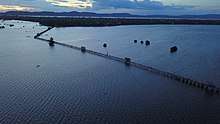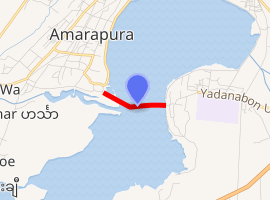U Bein Bridge
U Bein Bridge (Burmese: ဦးပိန် တံတား) is a crossing that spans the Taungthaman Lake near Amarapura in Myanmar. The 1.2-kilometre (0.75 mi) bridge was built around 1850 and is believed to be the oldest and (once) longest teakwood bridge in the world.[1][2][3] Construction began when the capital of Ava Kingdom moved to Amarapura,[4] and the bridge is named after the mayor who had it built.[5] It is used as an important passageway for the local people and has also become a tourist attraction and therefore a significant source of income for souvenir sellers.[1][5][6][7] It is particularly busy during July and August when the lake is at its highest.[8]
U Bein Bridge | |
|---|---|
 U Bein Bridge | |
| Coordinates | 21°53′29″N 96°3′22″E |
| Carries | 1 Lane |
| Crosses | Taung Tha Man Lake |
| Locale | Amarapura Township, Myanmar |
| Official name | U Bein Bridge, Amarapura |
| Other name(s) | Taung Tha Man Bridge |
| Characteristics | |
| Design | Wooden Foot Bridge (Teak Bridge) |
| Total length | Foot bridge 3,967 ft (1,209 m) or 482 spans or 0.75 miles (1.2 km) (total bridge) (1086 posts) |
| Width | 1 traffic lane |
| History | |
| Construction start | 1849 |
| Construction end | 1851 |

| |
The bridge was built from wood reclaimed from the former royal palace in Inwa. It features 1,086 pillars that stretch out of the water, some of which have been replaced with concrete. Though the bridge largely remains intact, there are fears that an increasing number of the pillars are becoming dangerously decayed. Some have become entirely detached from their bases and only remain in place because of the lateral bars holding them together. Damage to these supports have been caused by flooding as well as a fish breeding program introduced into the lake which has caused the water to become stagnant. The Ministry of Culture’s Department of Archaeology, National Museum and Library plans to carry out repairs when plans for the work are finalised.[1]
From 1 April 2009, eight police force personnel have been deployed to guard the bridge. Their presence is aimed at reducing anti-social behaviour and preventing criminal activities, with the first arrest coming in September 2013 when two men were reported for harassing tourists.[8]
Construction
The construction was started in 1849 and finished in 1851. Myanmar construction engineers used traditional methods of scaling and measuring to build the bridge. According to historic books about U Bein Bridge, Myanmar engineers made scale by counting the footsteps.
Design and Structure
The bridge was built in curved shape in the middle to resist the assault of wind and water. The main teak posts were hammered into the lake bed seven feet deep. The other ends of the posts were shaped conically to make sure that rain water would fall down easily. The joints of the bridge are intertwined.
Originally, there were 984 teak posts supporting the bridge and two approach brick bridges. Later the two approach brick bridges were replaced by wooden approach bridge. There are four wooden pavilions at the same interval along the bridge. By adding posts of two approach bridges and four pavilions, the number of posts amounts to 1089.
There are nine passageways in the bridge, where the floors can be lifted to let boats and barges pass. There 482 spans and the length of the bridge is 1,209 metres.
Gallery
 1855 by Colesworthey Grant
1855 by Colesworthey Grant October 1855
October 1855- November 2005
 January 2010
January 2010_Students_(2012).jpg) 2012
2012- January 2016
References
- Phyo Wai Kyaw; Than Naing Soe (24 June 2013). "U Bein Bridge at risk: locals". Myanmar Times. Retrieved 15 September 2013.
- "Oldest teak bridge". Hindustan Times. Archived from the original on 27 February 2012. Retrieved 15 September 2013.
- "Myanmar – The Big Picture". The Boston Globe. 26 March 2012. Retrieved 15 September 2013.
- "U Bein's Bridge". MyanmarBurma.com. Archived from the original on 12 July 2013. Retrieved 15 September 2013.
- "Amarapura and U Bein Bridge". Go-Myanmar.com. Retrieved 15 September 2013.
- "U Bein Bridge, U Bein Bridge Myanmar, U Bein Bridge Travel Guide & Tours". All Myanmar Tours. Archived from the original on 24 March 2013. Retrieved 15 September 2013.
- "U Bein Bridge, Myanmar (Burma)". www.peace-on-earth.org. Archived from the original on 20 February 2004. Retrieved 15 September 2013.
- Si Thu Lwin (9 September 2013). "Two arrested for harassing tourists at historic bridge". Myanmar Times. Retrieved 15 September 2013.
| Wikimedia Commons has media related to U Bein Bridge. |
